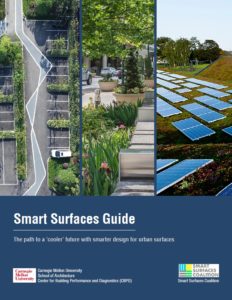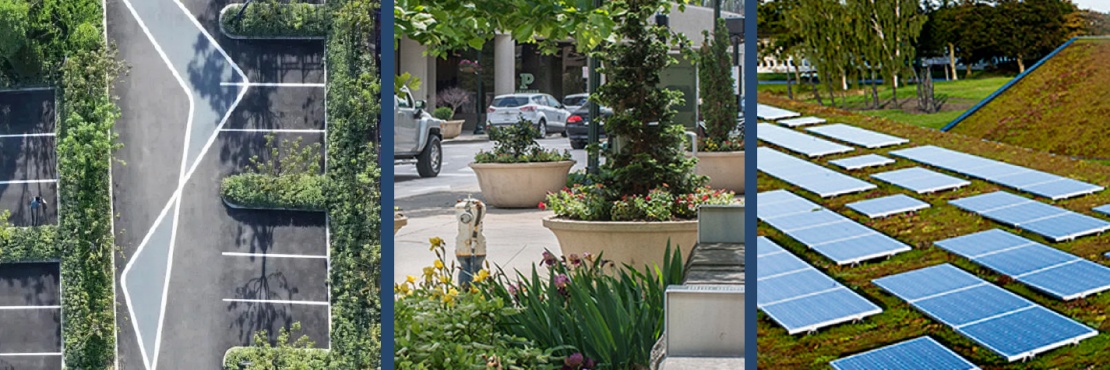Suzy Li of Carnegie Mellon Center for Building Performance and Diagnostics (CBPD) writes:
The Smart Surfaces Guidebook from Carnegie Mellon Center for Building Performance and Diagnostics (CBPD) provides comprehensive overview of materials and intervention scenarios to affordably reduce heat and flooding in urban areas.
In a summer with record high temperatures, one in three Americans reported facing extreme weather according to a new Gallup Poll. This number will only rise as the number of extreme heat and flooding events increases as a result of climate change. However, the newly released Smart Surfaces Guidebook aims to reduce the impact of extreme weather on urban areas by making the adoption of Smart Surfaces – including reflective, porous, and green surfaces, solar photovoltaics (PV), and trees – more accessible to city planners, architects, and engineers. A recent analysis on the costs and benefits of Smart Surfaces in Baltimore demonstrated that widespread adoption of these surfaces would lower city temperatures by as much as 5°F with a 10:1 benefit-cost ratio.
 The guidebook, written by Suzy Li of the Carnegie Mellon Center for Building Performance and Diagnostics (CBPD) in collaboration with the Smart Surfaces Coalition, includes case studies of Smart Surfaces in different environments, metrics for Smart Surfaces products, and intervention scenarios.
The guidebook, written by Suzy Li of the Carnegie Mellon Center for Building Performance and Diagnostics (CBPD) in collaboration with the Smart Surfaces Coalition, includes case studies of Smart Surfaces in different environments, metrics for Smart Surfaces products, and intervention scenarios.
Numerous stakeholders can utilize the guidebook to make informed decisions about Smart Surfaces adoption to both manage heat and water and mitigate GHG emissions in the urban environment.
Greg Kats, CEO and founder of the Smart Surfaces Coalition called the guidebook, “extremely informative, timely and valuable for anyone wanting to make their cities, towns, and developments cooler, more livable and more equitable.” Kats said that “extreme urban heat is awakening everyone to the reality of the climate crisis and the need to protect our communities and planet. This important study shows how, providing beautifully illustrated clear guidance on how Smart Surfaces can reshape urban surfaces to make them cooler, less likely to flood, healthier, more equitable and more livable. It could not be timelier.”
Vivian Loftness, Professor, and Former Head of the School of Architecture at Carnegie Mellon University noted the importance of the guidebook saying, “investments are made every day that could significantly improve the quality of our cities and towns. Designing smarter surfaces for our roofs, parking lots, streets and sidewalks can significantly reduce summer temperatures and flooding in our neighborhoods, while adding landscapes for walkability and solar collection for low carbon energy. This Smart Surface Guidebook provides beautiful illustrations and quantifies how we can update our neighborhood surfaces for a more sustainable future.”
“The guidebook is extremely informative, timely and valuable for anyone wanting to make their cities, towns, and developments cooler, more livable and more equitable.”
Greg Kats, CEO and founder of the Smart Surfaces Coalition
“This is a great new resource that provides illustrated and clear documentation on how to select and design using Smart Surfaces. It is an important contribution to aid people that want to use Smart Surfaces for its proven benefit in addressing urban heat islands, managing flooding and mitigating the impact of climate change”, says Georges C. Benjamin, MD, Executive Director of the American Public Health Association.
Clarence E. Anthony, CEO and Executive Director of the National League of Cities, attested to the value of the guidebook for communities across the country, saying, “Summer temperatures are at an all-time high time across the country, making it increasingly important for city leaders to take action and reduce heat risks for their residents. The Smart Surfaces Guide provides a wealth of examples for local leaders to draw from in considering what changes make the most sense for their communities.”
Jennifer Roberts, former Mayor of Charlotte notes that “many cities are finding, as the climate warms, that heat can be a killer. This guide not only provides options to mitigate those dangers, but it also gives cities real data for ways to work on equity and improve disparities, as neighborhoods that were formerly redlined experience even greater heat and flooding due to historic disinvestment. Every urban mayor should read this.”
###
About Carnegie Mellon University, Center for Building Performance and Diagnostics (CBPD)
The Center for Building Performance and Diagnostics (CBPD) at Carnegie Mellon University conducts research, demonstrations, and teaching to advance the sustainability and performance of buildings and communities. The CBPD research team included: Zekun (Suzy) Li, Vivian Loftness, Siqing Ge, Yi Zhou, Jiyuan Sui, Zehan Zhang, Juye Kim. [https://soa.cmu.edu/bpd]
About Smart Surfaces Coalition
The Smart Surfaces Coalition is committed to the rapid, cost-effective global adoption of Smart Surfaces to enable cities to thrive despite climate threats, save cities billions of dollars, create jobs, decrease heat, reduce flood risk, mitigate climate change, and improve city livability, health, and equity.
[https://smartsurfacescoalition.org/]
 Greenroofs.comConnecting the Planet + Living Architecture
Greenroofs.comConnecting the Planet + Living Architecture









